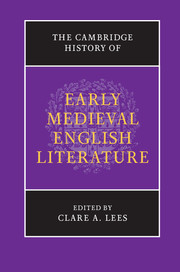Book contents
- Frontmatter
- Contents
- List of Illustrations
- List of Contributors
- Acknowledgements
- List of Abbreviations
- Introduction: literature in Britain and Ireland to 1150
- I WORD, SCRIPT AND IMAGE
- II EARLY ENGLISH LITERATURE
- 7 Across borders: Anglo-Saxon England and the Germanic world
- 8 English literature in the ninth century
- 9 The writing of history in the early Middle Ages: the Anglo-Saxon Chronicle in context
- 10 The literary languages of Old English: words, styles, voices
- 11 Old English poetic form: genre, style, prosody
- 12 Beowulf: a poem in our time
- 13 Old English lyrics: a poetics of experience
- 14 Literature in pieces: female sanctity and the relics of early women’s writing
- 15 Saintly lives: friendship, kinship, gender and sexuality
- 16 Sacred history and Old English religious poetry
- 17 Performing Christianity: liturgical and devotional writing
- 18 Riddles, wonder and responsiveness in Anglo-Saxon literature
- III LATIN LEARNING AND THE LITERARY VERNACULARS
- Bibliography
- Index of manuscripts
- Index
17 - Performing Christianity: liturgical and devotional writing
from II - EARLY ENGLISH LITERATURE
Published online by Cambridge University Press: 05 February 2013
- Frontmatter
- Contents
- List of Illustrations
- List of Contributors
- Acknowledgements
- List of Abbreviations
- Introduction: literature in Britain and Ireland to 1150
- I WORD, SCRIPT AND IMAGE
- II EARLY ENGLISH LITERATURE
- 7 Across borders: Anglo-Saxon England and the Germanic world
- 8 English literature in the ninth century
- 9 The writing of history in the early Middle Ages: the Anglo-Saxon Chronicle in context
- 10 The literary languages of Old English: words, styles, voices
- 11 Old English poetic form: genre, style, prosody
- 12 Beowulf: a poem in our time
- 13 Old English lyrics: a poetics of experience
- 14 Literature in pieces: female sanctity and the relics of early women’s writing
- 15 Saintly lives: friendship, kinship, gender and sexuality
- 16 Sacred history and Old English religious poetry
- 17 Performing Christianity: liturgical and devotional writing
- 18 Riddles, wonder and responsiveness in Anglo-Saxon literature
- III LATIN LEARNING AND THE LITERARY VERNACULARS
- Bibliography
- Index of manuscripts
- Index
Summary
Modern views of Anglo-Saxon religious writing are drawn to its perceived summits: biblical and hagiographic verse, prose translations of Scripture and the abundant sermons and homilies. Such views can distort, however, by isolating landmarks from their surrounding terrain. This chapter concerns two parts of that terrain, still only vaguely mapped: liturgical writings that directed, or aspired to direct, Christian public worship, and devotional prayers. Existing literary histories offer useful, if partial, coverage of primary texts attributed to either category. No definitive handlist has yet been compiled, partly because the phenomena of ‘liturgy’ and ‘devotion’ resist our taxonomies, and a historical perspective on the meaning of that resistance ought to precede the analysis of relevant texts.
The goal of this essay is therefore not a new inventory so much as a new focus on the enmeshment of liturgy, devotion and literary invention seen, in various forms, across a selection of writings from England between c. 800 and c. 1100. In its first two parts, the chapter considers examples of liturgical and devotional composition, in Latin and Old English, which bear witness to the sheer productivity of those forms and to the complexity of their interactions. The latter half of the essay seeks to apply the lessons of the former to some more ambiguous cases, first to so-called liturgical poetry in Old English, then, briefly, to a few better-known Old English poems in which modern critics find ‘liturgical’ or ‘devotional’ symptoms. The chapter concludes with questions for future research, encouraging a more nuanced integration of literary history with these two fundamental expressions of medieval Christianity.
- Type
- Chapter
- Information
- The Cambridge History of Early Medieval English Literature , pp. 427 - 450Publisher: Cambridge University PressPrint publication year: 2012
- 1
- Cited by



